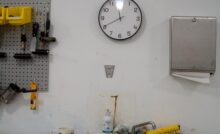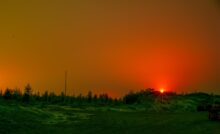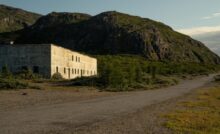Categories: American-Scandinavian Foundationcontemporary fine art photographyFine arts photographFulbright Scholar FellowLandscape PhotographyNight Landscape PhotographyNightlandscape Fine Art PhotographySteve GiovincoUncategorized
I Photograph Arctic Climate Change at Night in Greenland


I Photograph Arctic Climate Change at Night in Greenland
I Capture Arctic Climate Change at Night.
Spanning history, environmentalism and primordial beauty, I trace the lyrical night landscapes of Greenland and document irreversible environmental changes there. While these photographs crystallize a feeling of inertia happening among the fjords, glaciers and communities, they also capture a haunting, primordial feeling.
This photograph was taken while trekking eight hours to photograph a dying glacier. A few days before, this valley was a torrent of water due to a sudden break in the glacial lake where melting water collected but suddenly burst (thankfully, I planned the right day to walk, otherwise I would have been killed).
Museum of Contemporary Art Georgia (MoCA GA) exhibited this piece last year, and I am a Fulbright Program finalist.
Next Planned Trip
Funding would help travel to a different, more remote area: East Greenland, one of the most isolated places in the world. Along the 12,000 mile coastline there are only two towns and five small settlements inhabited by no more than 3,500 people. Unlike their counterparts in West Greenland, Inuit here were marginally influenced by European culture. So remote is this area that even a separate language, East Greenlandic, developed. But melting ice impacts seal, whale and polar bear hunting, leading to declining income, forcing native peoples to change or move. As a result of unprecedented cultural upheaval, suicide rates and alcoholism spiked; East Greenland has the highest of both.
Set in this extreme isolation is one the largest and fastest retreating glaciers. Moving at about three feet an hour–you can almost see it move–is the Helheim Glacier (aptly named after the “realm of the dead” in Norse Mythology). This is climate change incarnate. So intense is the rapid melting that it creates a special category of earthquake known as a glacialquake.
Artistic Inspiration
Working at night requires very long exposures of an hour or more. Making it nearly impossible to see through the viewfinder, I instead stand beside the camera “feeling” the image and intuitively framing it in the dark. By allowing my own thoughts and fears to be part of the creative photographic process, I make a visual representation of this unfolding emotional experience, trying to capture mystery.
Artistic inspiration is loosely based on Hudson River Landscape painters such as Frederic Edwin Church, and others such as William Bradford, who explored the desolate coast of Labrador. Additionally, the project is informed by Scandinavian and German cinema (Ingmar Bergman and Rainer Werner Fassbinder), and films my father would bring home to play in our darkened basement.
Initial Interest and Background
This project is part of a long-term series spanning history, environmentalism and primordial beauty, representing an arc of photographs taken in remote Northern settings at twilight and at night. When photographing in Newfoundland, Canada, at the spot where Leif Erikson is believed to have sailed from Greenland to North America in the Tenth Century, I became interested in history and global climate change. This lead me to Greenland’s melting ice sheet, where I completed the first part of “Inertia.” While much of the project’s focus is on the landscape, the impact of warming temperatures on politics and local Inuit culture are of interest too.
Photographing eerie remote changing landscapes at night has become my sole creative endeavor. Most importantly, I feel it is crucial to complete the project in 2019 before the pristine arctic landscape metamorphose further.
Framed, 30×44”
No border, with one inch wood frame, Plexiglas front.
Note: this was sized slightly smaller to accommodate the exhibition at MoCA (Georgia). The normal edition size is 37×50″.
A photograph sold at Sothebys in 2008.
Recent Posts
Exhibiting at 18th Jeonju International Photography Festival
I’m excited to be included in the 18th Jeonju International Photography Festival, taking place from…
1 month ago
Photographs of Abandoned US Base, Greenland
With support from the American-Scandinavian Foundation and VisitGreenland, I spent a month photographing in Narsarsuaq,…
2 months ago
How to Improve Your Online Visibility: Effective SEO Tips for Photographers
As photographers, the first impression potential clients, art dealers or museum curators have is to…
3 months ago
The Unsettling Beauty of Color: Far from Heaven, Fassbinder, Eggleston
As I sat after seeing Far from Heaven last night, the Question and Answer conversation…
4 months ago





